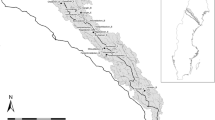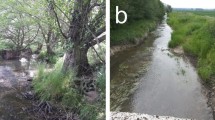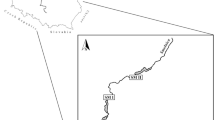Abstract
Riverine wetlands, which provide numerous valuable functions, are disappearing in floodplains of a channelized European river. A restoration project has been proposed by scientists to restore a former braided channel of the Rhône River by the removal of fine organic sediments in order to enhance groundwater supply. A precise and intensive prerestoration monitoring program during one year (including comparison with a reference channel) has taken into account several variables and ecological performance indicators measured at various spatial and temporal scales. Three restoration techniques were then suggested, taking into account two characteristics of ecosystem functions for increasing restoration success and self-sustainability: (1) the riparian forest as well as the shores must be preserved or disturbed as little as possible; and (2) the upstream alluvial plug must be preserved to prevent direct supply of nutrientrich water from the Rhône River. Among the three restoration options proposed, it was not possible to carry out the less ecologically disturbing one as it was considered too expensive, time consuming, and difficult to realize. A precise and intensive postrestoration monitoring program, conducted over two years, demonstrated restoration success but also unpredicted problems, such as a locally thick layer of fine organic sediment. As long as a self-sustainable state is not achieved, this monitoring should be continued. Afterwards, a less precise and less intensive long-term monitoring should enable the detection of future events that may influence ecosystem changes.
Similar content being viewed by others
Literature Cited
Amoros, C. 1991. Changes in side-arm connectivity and implications for river system management.Rivers 2:105–112.
Amoros, C., and A. L. Roux. 1988. Interaction between water bodies within the floodplains of large rivers: Function and development of connectivity.Münstersche Geographische Arbeiten 29:125–130.
Amoros, C., J. C. Rostan, G. Pautou, and J. P. Bravard. 1987a. The reversible process concept applied to the environmental management of large river systems.Environmental Management 11:607–617.
Amoros, C., A. L. Roux, J. L. Reygrobellet, J. P. Bravard, and G. Pautou. 1987b. A method for applied ecological studies of fluvial hydrosystems.Regulated Rivers 1:17–36.
Balocco-Castella, C. 1988. Les macrophytes aquatiques des milieux abandonnés par le Haut-Rhône et l'Ain: diagnostic phyto-écologique sur l'évolution et le fonctionement de ces écosystèmes. PhD thesis. University Claude Bernard Lyon I, France, 150 pp+36 appendixes.
Barrat, M. H., and C. Amoros, 1995. Influence of flood timing on the recovery of macrophytes in a former river channel.Hydrobiologia (in press).
Berryman, A. A., M. A. Valenti, M. J. Harris, and D. C. Fulton. 1992. Ecological engineering: An idea whose time has come?Trends in Ecology and Evolution 7:268–270.
Björk, S. 1992. Principles and methods for the restoration of shallow lakes and wetlands. Pages 56–60in C. M. Finlayson (ed.), Integrated management and conservation of wetlands in agricultural and forested landscapes. Proceedings of a workshop, 25–31 March 1992. Trebon, Czechoslovakia. International Waterfowl and Wetlands Research Bureau special publication number 22.
Bornette, G., C. Amoros, and D. Chessel. 1994a. Effect of allogenic processes on successional rates in former river channels.Journal of Vegetation Science 5:237–246.
Bornette, G., C. Amoros, and G. Collilieux. 1994b. Role of seepage supply in aquatic vegetation dynamics in former river channels: Prediction testing using a hydroelectric construction.Environmental Management 18:223–234.
Bravard, J. P., C. Amoros, and G. Pautou. 1986. Impact of civil engineering works on the successions of communities in a fluvial system. A methodological and predictive approach applied to a section of the Upper Rhône River, France,Oikos 47:92–111.
Carbiener, R., M. Trémolières, J. L. Mercier, and A. Ortscheit, 1990. Aquatic macrophyte communities as bioindicators of eutrophication in calcareous oligosaprobe stream waters (Upper Rhine plain. Alsace).Vegetatio 86:71–88.
Carrel, G. 1986. Caractérisation physico-chimique du Haut-Rhône français et de ses annexes; incidences sur la croissance des populations d'alevins. PhD thesis. University Claude Bernard Lyon I, France, 185 pp.
Castella, E. 1987. Apport des macroinvertébrés aquatiques au diagnostic écologique des écosystèmes abandonnés par les fleuves. Recherches méthodologiques sur le Haut-Rhône français. PhD thesis. University Claude Bernard Lyon I, France, 2 vol., 229 and 233 pp.
Castella, E., C. Castella, and C. Amoros. 1986. Évolution d'anciens chenaux du Rhône après la mise en service de l'aménagement de Brégnier-Cordon. Unpublished report to Compagnie Nationale du Rhône, 50 pp.
Castella, E., C. Castella, and C. Amoros. 1987. Évolution d'anciens chenaux du Rhône après la mise en service de l'aménagement de Brégnier-Cordon. Année 1986. Unpublished report to Compagnie Nationale du Rhône, 46 pp.
Castella, E., C. Castella, and C. Amoros. 1988. Évolution d'anciens chenaux du Rhône après la mise en service de l'aménagement de Brégnier-Cordon. Année 1987. Unpublished report to Compagnie Nationale du Rhône, 41 pp.
Castella, E., G. Bornette, and C. Amoros. 1990. Évolution d'anciens chenaux du Rhône après la mise en service de l'aménagement de Brégnier-Cordon. Année 1987. Unpublished report to Compagnie Nationale du Rhône, 41 pp.
Castella, E., G. Bornette, and C. Amoros. 1990. Évolution d'anciens chenaux du Rhône après la mise en service de l'aménagement de Brégnier-Cordon. Année 1989. Unpublished report to Compagnie Nationale du Rhône, 25 pp.
Conners, M. E., and R. Naiman, 1984. Particulate allochthonous inputs: Relationships with stream size and undisturbed watershed.Canadian Journal of Fisheries and Aquatic Sciences 41:1473–1484.
Copp, G. H. 1987. Le rôle et le fonctionnement des milieux aquatiques du Haut-Rhône français comme sites de reproduction et de nurserie pour les poissons du fleuve. PhD thesis. University Claude Bernard Lyon I, France, 97 pp.
Cummins, K. W., G. W. Minshall, J. R. Sedell, C. E. Cushing, and R. C. Petersen. 1984. Stream ecosystem theory.Verhandlungen der Internationalen Vereinigung für theoretische und angewandte Limnologie 22:1818–1827.
Dannapfel, K. H. 1977. Faunistik und Ökologie von Wasserkäfern im Naturschutzgebiet “Hördter Rheinaue” bei Germersheim (Insecta: Coleoptera).Mitteilungen der Pollichia 65:5–81.
Foeckler, F. 1990. Charakterisierung und Bewertung von Augewässern des Donauraums Straubing durch Wassermolluskengesellschaften. Berichte der Bayerische Akademie für Naturschutz und Landschaftspflege, Laufen, Beiheft 7, 154 pp.
Gore, J. A. 1985. Mechanisms of colonization and habitat enhancement for benthic macroinvertebrates in restored river channels. Pages 91–101in J. A. Gore (ed.). The restoration of rivers and streams: Theories and experience. Butterworth, Stoneham, Massachusetts.
Henry, C. P., and C. Amoros. 1995. Restoration ecology of riverine wetlands: I. A scientific base.Environmental Management 19:891–902.
Henry, C. P., G. Bornette, and C. Amoros. 1992. Écotechnologie de restauration de zones humides fluviales: Recherches expérimentales sur les bras-morts du Rhône. Premier rapport: État initial avant restauration. Année 1992. Unpublished report to Compagnie Nationale du Rhône, 48 pp.+19 appendixes.
Henry, C. P., G. Bornette, and C. Amoros. 1993. Écotechnologie de restauration de zones humides fluviales: Recherches expérimentales sur les bras-morts du Rhône. Deuxième rapport: Première année après restauration. Année 1993. Unpublished report to Compagnie Nationale du Rhône, 134 pp.+21 appendixes.
Henry, C. P., G. Bornette, and C. Amoros. 1994. Écotechnologie de restauration de zones humides fluviales: Recherches expérimentales sur les bras-morts du Rhône. Rapport final: deuxième année après restauration. Année 1994. Unpublished report to Compagnie Nationale de Rhône, 158 pp. +27 appendixes.
Henry, C. P., C. Amoros, and G. Bornette. 1995. Species traits and recolonization processes after flood disturbances in riverine macrophytes.Vegetatio (in press).
Higler, L. W. G. 1993. The riparian community of north-west European lowland streams.Freshwater Biology 29:229–241.
Husák, S., and F. Krahulec. 1994. Monitoring successional and other changes in wetland plant communities. Pages 197–209in G. Aubrecht, G. Dick, and C. Prentice (eds.), Monitoring of ecological change in wetlands of Middle Europe. Proceedings of an international workshop, October 1993. Linz, Austria. International Waterfowl and Wetlands Research Bureau publication number 30.
Hynes, H. B. N. 1975. The stream and its valley.Verhandlungen der Internationalen Vereinigung für theoretische und angewandte Limnologie 19:1–15.
Juget, J., B. J. Yi, C. Roux, P. Richoux, M. Richardot-Coulet, J. L. Reygrobellet, and C. Amoros. 1979. Structure et fonctionnement des écosystèmes du Haut-Rhône français. VII. Le complexe hydrographique de la Lône des Pêcheurs (un ancient méandre du Rhône).Schweizerische Zeitschrift für Hydrologie 41:395–417.
Junk, W. J., P. B. Bayley, and R. E. Sparks. 1989. The flood pulse concept in river-floodplain systems.In D. P. Dodge (ed.), Proceedings of the International Large River Symposium.Canadian Special Publication of Fisheries and Aquatic Sciences 106:110–127.
Kinzelbach, R. 1976a. Das Naturschutzgebiet “Hördter Rheinaue” bei Germersheim. Einführung in ökographie, Ökologie, Pflege und Ausbau.Mitteilungen der Pollichia 64:5–62.
Kinzelbach, R. 1976b. Die Wassermollusken des Naturschutzgebiet “Hördter Rheinaue.”Mitteilungen der Pollichia 64: 138–152.
Kohler, A., R. Brinkmeier, and H. Vollrath. 1974. Verbreitung und Indikatorwert der submersen Macrophyten in den Fliessgewässern der friedberger Au.Bericht der Bayerischen botanischen Gesellschaft zur Erforschung der heimischen Flora 45:5–36.
Lejmbach, B. 1977. The influence of flowing water velocity on the structure of underwater phytocenosis.Fragmental Floristica et Geobotanica 22:355–362.
Naiman, R. J., and H. Décamps. 1990. The ecology and management of aquatic-terrestrial ecotones. Man and biosphere series, vol. 4, Parthenon Press, London, 316 pp.
Naiman, R. J., H. Décamps, J. Pastor, and C. A. Johnston. 1988. The potential importance of boundaries to fluvial ecosystems.Journal of the North American Benthological Society 7:289–306.
Nilsson, C. 1992. Conservation management of riparian communities. Pages 352–372in L. Hansson (ed.) Ecological principles of nature conservation. Elsevier Applied Science, London.
Odum, E. P. 1971 Fundamentals of ecology, 3rd ed. W. B. Saunders, Philadelphia, 574 pp.
Peterjohn, W. T., and D. L. Corell. 1984. Nutrient dynamics in an agricultural watershed: Observations on the role of a riparian forest.Ecology 65:1466–1475.
Petit, F., and R. Schumacker. 1985. L'utilisation des plantes aquatiques comme indicateur du type d'activité géomorphologique d'une rivière ardennaise (Belgique).Colloques Phytosociologiques 13:691–710.
Pinay, G., H. Décamps, H. Chauvet, and E. Fustec. 1990. Functions of ecotones in fluvial systems Pages 141–169in R. J. Naiman and H. Décamps (eds.), The ecology and management of aquatic terrestrial ecotones. UNESCO, Paris, and Parthenon Publishing Group, Carnforth.
Rostan, J. C., C. Amoros, and J. Juget. 1987. The organic content of the surficial sediment: a method for the study of ecosystems development in abandoned river channels.Hydrobiologie 148:45–62.
Roux, A. L., J. P., Bravard, C. Amoros, and G. Pautou. 1989. Ecological changes of the French Upper Rhône River since 1750. Pages 323–350in G. E. Petts (ed.). Historical change of large alluvial rivers: Western Europe. John Wiley & Sons, Chichester, UK.
Sirjola, E. 1969. Aquatic vegetation of the river Teuronjoki, south Finland, and its relation to water velocity.Annales Botanici Fennici 6:68–75.
Wiegleb, G. 1978. Untersuchungen über den Zusammenhang zwischen hydrochemischen Umweltfktoren und Macrophytenvegetation in stehenden Gewässern.Archiv für Hydrobiologie 83:443–484.
Zedler, J. B., and M. W. Weller. 1990. Overview and future directions. Pages 405–413in J. A. Kusler and M. E. Kentula (eds.), Wetland creation and restoration: The status of the science. Island Press, Washington, DC.
Author information
Authors and Affiliations
Rights and permissions
About this article
Cite this article
Henry, C.P., Amoros, C. & Giuliani, Y. Restoration ecology of riverine wetlands: II. An example in a former channel of the Rhône River. Environmental Management 19, 903–913 (1995). https://doi.org/10.1007/BF02471941
Issue Date:
DOI: https://doi.org/10.1007/BF02471941




